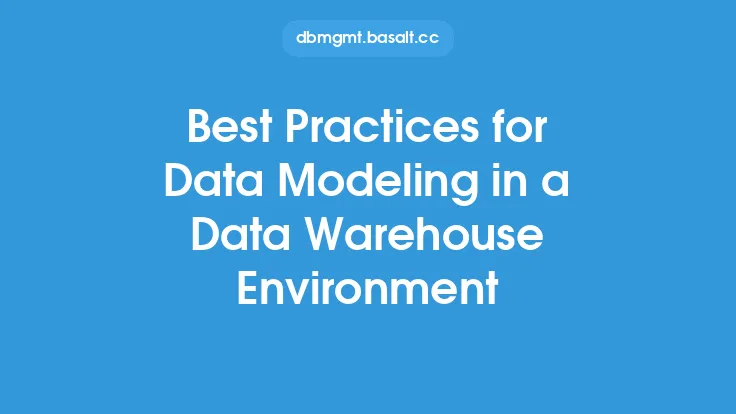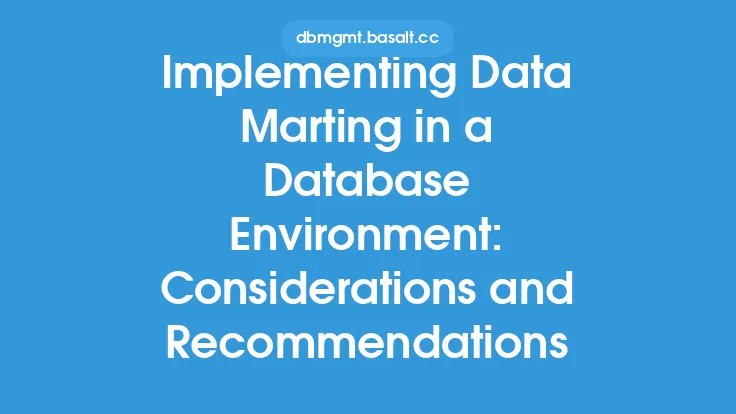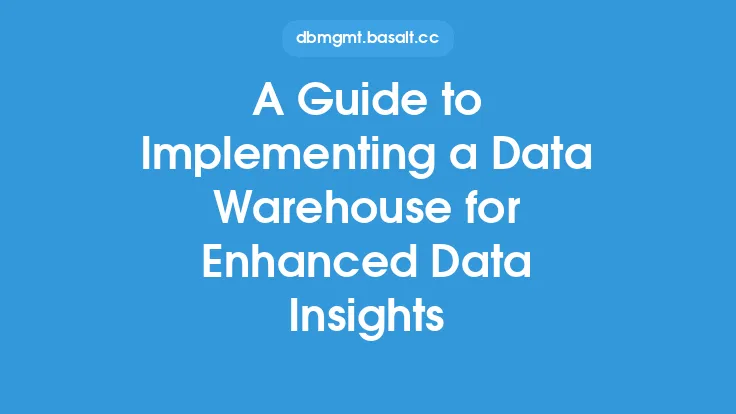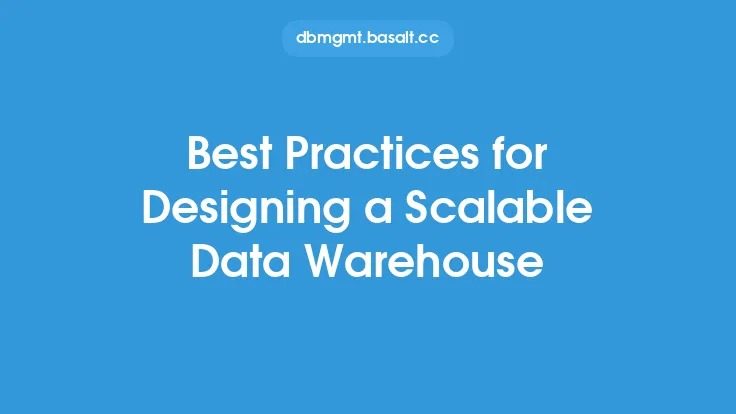Implementing data cleansing in a data warehouse environment is a critical process that ensures the accuracy, completeness, and consistency of data. Data warehouses are designed to store large amounts of data from various sources, and over time, this data can become corrupted, outdated, or inconsistent. Data cleansing is the process of identifying and correcting errors, inconsistencies, and inaccuracies in the data to ensure that it is reliable and usable for analysis and decision-making.
Introduction to Data Warehouse Environment
A data warehouse is a centralized repository that stores data from various sources, including transactional databases, log files, and external data sources. The data is extracted, transformed, and loaded (ETL) into the data warehouse, where it is stored in a structured and organized manner. The data warehouse environment is designed to support business intelligence activities, such as reporting, analysis, and data mining. However, the data in the data warehouse can become dirty or corrupted due to various reasons, such as data entry errors, system glitches, or inconsistencies in data formatting.
Data Cleansing Process
The data cleansing process involves several steps, including data profiling, data validation, data standardization, and data transformation. Data profiling involves analyzing the data to identify patterns, trends, and anomalies. Data validation involves checking the data against a set of rules and constraints to ensure that it is accurate and consistent. Data standardization involves converting the data into a standard format to ensure that it is consistent and comparable. Data transformation involves converting the data into a format that is suitable for analysis and reporting.
Data Cleansing Techniques
There are several data cleansing techniques that can be used in a data warehouse environment, including data scrubbing, data parsing, and data matching. Data scrubbing involves removing duplicate or unnecessary data to improve data quality. Data parsing involves breaking down complex data into simpler components to improve data analysis. Data matching involves identifying and merging duplicate records to improve data consistency. These techniques can be used individually or in combination to achieve the desired level of data quality.
Data Cleansing Tools and Software
There are several data cleansing tools and software available that can be used to implement data cleansing in a data warehouse environment. These tools include data quality software, data integration software, and data governance software. Data quality software is designed to identify and correct data errors, inconsistencies, and inaccuracies. Data integration software is designed to integrate data from multiple sources and transform it into a consistent format. Data governance software is designed to manage and monitor data quality and ensure that it is compliant with regulatory requirements.
Data Warehouse Design Considerations
When designing a data warehouse, it is essential to consider data cleansing requirements. The data warehouse design should include provisions for data cleansing, such as data validation rules, data standardization rules, and data transformation rules. The design should also include provisions for data quality monitoring and reporting to ensure that data quality issues are identified and addressed promptly. Additionally, the design should include provisions for data governance and compliance to ensure that data is handled and stored in accordance with regulatory requirements.
Data Cleansing and Data Normalization
Data cleansing and data normalization are closely related concepts. Data normalization involves organizing data into a structured and consistent format to improve data analysis and reporting. Data cleansing is a critical step in the data normalization process, as it ensures that the data is accurate, complete, and consistent. Data normalization techniques, such as first normal form (1NF), second normal form (2NF), and third normal form (3NF), can be used to normalize data and improve data quality.
Benefits of Data Cleansing
Implementing data cleansing in a data warehouse environment has several benefits, including improved data quality, improved data analysis, and improved decision-making. Data cleansing ensures that data is accurate, complete, and consistent, which improves the reliability of data analysis and reporting. Data cleansing also improves data governance and compliance by ensuring that data is handled and stored in accordance with regulatory requirements. Additionally, data cleansing improves data integration and interoperability by ensuring that data is in a consistent format.
Challenges and Limitations
Implementing data cleansing in a data warehouse environment can be challenging and time-consuming. The process requires significant resources and expertise, particularly in large and complex data warehouse environments. Additionally, data cleansing can be a continuous process, as new data is added to the data warehouse, and existing data becomes outdated or corrupted. Furthermore, data cleansing can be limited by the quality of the source data, and the availability of resources and expertise.
Best Practices
To implement data cleansing effectively in a data warehouse environment, several best practices should be followed. These include establishing clear data quality standards, implementing data validation and data standardization rules, and monitoring data quality regularly. Additionally, data cleansing should be integrated into the data warehouse design and development process to ensure that data quality issues are addressed promptly. Furthermore, data cleansing should be performed regularly to ensure that data remains accurate, complete, and consistent over time.
Conclusion
Implementing data cleansing in a data warehouse environment is a critical process that ensures the accuracy, completeness, and consistency of data. The process involves several steps, including data profiling, data validation, data standardization, and data transformation. Several data cleansing techniques, tools, and software are available to implement data cleansing, and the process should be integrated into the data warehouse design and development process. By following best practices and establishing clear data quality standards, organizations can ensure that their data is reliable, usable, and compliant with regulatory requirements.





